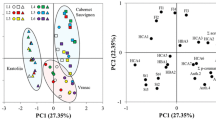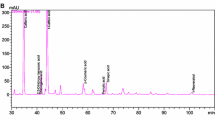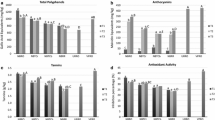Abstract
Two wines, obtained respectively from Greco grapes submitted to (a) a traditional vinification in white and (b) a vinification including cryomaceration under reductive conditions, were aged for 12 months in glass container and in 3 types of amphorae (raw, glazed, and engobe). The wines obtained by cryomaceration under reductive conditions showed the highest phenolic contents both at racking and after aging. The phenolic contents decreased with aging and proanthocyanidins exhibited the greatest decrease. Antiradical/antioxidant activity at racking and after aging was higher in cryomacerated than in traditional wines. Antioxidant activity was not affected by the type of container. Volatile acids and esters decreased with aging, while alcohols, hydrocarbons, and aromatics increased. According to the principal component analysis (PCA) of results from conventional analyses and antioxidants, the wines were homogeneously grouped as a function of the vinification method applied. The PCA of volatile compounds allows to better emphasize the differences, grouping the data into three clusters according to the type of containers.


Similar content being viewed by others
References
Gambacorta G, Antonacci D, Pati S, La Gatta M, Faccia M, Coletta A, La Notte E (2011) Influence of winemaking technologies on phenolic composition of Italian red wines. Eur Food Res Technol 233:1057–1066
Hernanz D, Recamales AF, Lourdes González-Miret M, Gomez-Míguez MJ, Vicario IM, Heredia FJ (2007) Phenolic composition of white wines with a prefermentative maceration at experimental and industrial scale. J Food Eng 80:327–335
Baiano A, Varva G, De Gianni A, Terracone C, Viggiani I, Del Nobile MA (2013) Effects of different vinification technologies on physico-chemical properties and antioxidant activity of ‘Falanghina’ and ‘Bombino bianco’ wines. Eur Food Res Technol 237:831–842
Proestos C, Bakogiannis A, Psarianos C, Koutinas A, Kanellaki M, Komaitis M (2005) High performance liquid chromatography analysis of phenolic substances in Greek wines. Food Control 16:319–323
Chatonnet P, Dubourdieu D, Boidron JN (1992) Incidence des conditions de fermentation at d’èlevage des vins blanc secs en barriques sur leur composition in substances cèdèes par le bois de chêne. Sci Aliment 12:665–685
Kallithraka S, Salacha MI, Tzourou I (2009) Changes in phenolic composition and antioxidant activity of white wine during bottle storage: Accelerated browning test versus bottle storage. Food Chem 113:500–505
Baiano A, Varva G, De Gianni A, Viggiani I, Terracone C, Del Nobile MA (2014) Differences in physical-chemical characteristics and antioxidant profiles of ‘Falanghina’ white wines during aging in amphorae. Food Chem 146:226–233
Baiano A, Mentana A, Quinto M, Centonze D, Longobardi F, Ventrella A, Agostiano A, Varva G, De Gianni A, Terracone C, Del Nobile MA (2015) The effect of in-amphorae aging on oenological parameters, phenolic profile and volatile composition of Minutolo white wine. Food Res Int 74:294–305
EEC Regulation 2676 (1990). Community methods for the analysis of wine Official Journal of European Communities. L272 pp 1–192
Singleton VL, Rossi JA (1965) Colorimetry of total phenolics with phosphomolybdic phosphotungstic acid reagents. Am J Enol Vitic 16:144–158
Di Stefano R, Cravero MC, Gentilizi N (1989) Metodi per lo studio dei polifenoli dei vini. L’Enotecnico 5:83–89
Di Stefano R, Cravero MC (1991) Metodi per lo studio dei polifenoli delle uve. Rivista di Viticoltura ed Enologia 2:37–43
Brand-Williams W, Cuvelier ME, Berset C (1995) Use of a free radical method to evaluate antioxidant activity. LWT-Food Sci Technol 28:25–30
Re R, Pellegrini N, Proteggente A, Pannala A, Yang M, Rice-Evans C (1999) Antioxidant activity applying an improbe ABTS radical cation decolorization assay. Free Radic Biol Med 26:1231–1237
Canuti V, Conversano M, Li Calzi M, Heymann H, Matthews MA, Ebeler SE (2009) Headspace solid-phase microextraction–gas chromatography–mass spectrometry for profiling free volatile compounds in Cabernet Sauvignon grapes and wines. J Chromatogr A 1216:3012–3022
Tao Y, Li H, Wang H, Zhang Li (2008) Volatile compounds of young Cabernet Sauvignon red wine from Changli County (China). J Food Comp Anal 21:689–694
Baiano A, Terracone C, Longobardi F, Ventrella A, Agostiano A, Del Nobile MA (2012) Effects of different vinification technologies on physical and chemical characteristics of Sauvignon blanc wines. Food Chem 135:2694–2701
Ribéreau-Gayon P, Dubourdieu D, Donèche B, Lonvaud A (2000) Handbook of Enology. The microbiology of wine and vinifications, vol 1. Wiley, Chichester
Piombino P, Genovese A, Gambuti A et al (2010) Effects of off-vine bunches shading and cryomaceration on free and glycosylated flavours of Malvasia delle Lipari wine. Int J Food Sci Technol 45:234–244
Antonelli A, Arfelli G, Masino F et al (2010) Comparison of traditional and reductive winemaking: influence on some fixed components and sensorial characteristics. Eur Food Res Technol 231:85–91
Carillo M, Formato A, Fabiani A et al (2011) An inertizing and cooling process for grapes cryomaceration. Electron J Biotechnol 14:1–14
Lan YY, Tao YS, Tian T, Hu ZY, Peng CT (2014) The effect of pre-fermentative freezing treatment on the sensory quality of ‘meii’ rosé wine. S Afr J Enol Vitic 35:257–263
Yousef MI, Saad AA, El-Shennawy LK (2009) Protective effect of grape seed proanthocyanidin extract againstoxidative stress induced by cisplatin in rats. Food Chem Toxicol 47:1176–1183
Martysiak-Zurowska D, Wenta W (2012) A comparison of ABTS and DPPH methods for assessing the total antioxidant capacity of human milk. Acta Sci Pol Technol Aliment 11:83–89
Capone S, Tufariello M, Francioso L, Montagna G, Casino F, Leone A, Siciliano P. (2013) Aroma analysis by GC/MS and electronic nose dedicated to Negroamaro and Primitivo typical Italian Apulian wines. Sensor Actuat B Chem 179:259–269
SAFC (2008) Flavors and fragrances. European Ed. Catalogue 2007–2008. SAFC Specialities, Madrid
Nykänen L (1986) formation and occurrence of flavor compounds in wine and distilled alcoholic beverages. Am J Enol Vitic 37:84–96
Lambropoulos I, Roussis IG (2007) Inhibition of the decrease of volatile esters and terpenes during storage of a white wine and a model wine medium by caffeic acid and gallic acid. Food Res Int 40:176–181
Ferreira V, Escudero A, Fernández P, Cacho JF (1997) Changes in the profile of volatile compounds in wines stored under oxygen and their relationship with the browning process. Z Lebensm Unters Forsch A 205:392–396
Câmara JS, Alves MA, Marques JC (2006) Changes in volatile composition of Madeira wines during their oxidative ageing. Anal Chim Acta 563:188–197
Ramey DD, Ough CS (1980) Volatile ester hydrolysis or formation during storage of model solutions and wines. J Agric Food Chem 28:928–934
Usseglio-Tomasset L, Di Stefano R (1980) Profilo aromatico del Moscato bianco del Piemonte. Riv Vitic Enol 33:58–67
Peinado RA, Moreno J, Bueno JE, Moreno JA, Mauricio JC (2004) Comparative study of aromatic compounds in two young white wines subjected to pre-fermentative cryomaceration. Food Chem 84:585–590
Author information
Authors and Affiliations
Corresponding author
Ethics declarations
Compliance with ethics requirements
This article does not contain any studies with human or animal subjects.
Conflict of interest
The author has no conflict of interest to declare.
Rights and permissions
About this article
Cite this article
Baiano, A., Mentana, A., Varva, G. et al. Effects of different vinification procedures and aging containers on phenolic and volatile composition of Greco white wines. Eur Food Res Technol 243, 1667–1680 (2017). https://doi.org/10.1007/s00217-017-2874-6
Received:
Revised:
Accepted:
Published:
Issue Date:
DOI: https://doi.org/10.1007/s00217-017-2874-6




